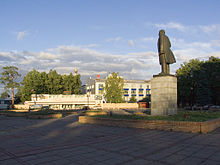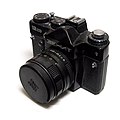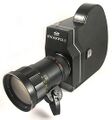Krasnogorsky Zavod
Topic: Company
 From HandWiki - Reading time: 3 min
From HandWiki - Reading time: 3 min
 | |
| Type | PJSC |
|---|---|
| Industry | Optical engineering, optoelectronics |
| Founded | Krasnogorsk, Russia (1942) |
| Headquarters | Krasnogorsk, Moscow Oblast , |
Key people | Alexander Novikov (director) |
| Products | Cameras, night vision devices, rangefinders, military optics |
| Parent | Shvabe (Rostec) |
| Website | Official page at Shvabe site |
Krasnogorsky zavod (Russian: Красногорский завод им. С. А. Зверева, lit. 'Krasnogorsk Works named after S. A. Zverev') is a Russian factory in Krasnogorsk near Moscow which specializes in optical technology. Part of Shvabe Holding (Rostec state corporation).[1]
During the Soviet period it was called Krasnogorsk Mechanical Works (Красногорский механический завод, Krasnogorskiy Mechanicheskiy Zavod). The abbreviation KMZ (КМЗ) is still in common use.
Products
KMZ is known largely for its photographic and movie cameras of the Zorki, Zenit and Krasnogorsk series, several million of which were produced. It also has a large military optics and mechanical engineering division.
Zorki 4 rangefinder camera
Zenit 12 SLR camera
Krasnogorsk-3 movie camera
Horizon 202 panoramic camera
History
Founding and post-war years
After the German invasion of the Soviet Union in World War II, the Red Army had acute need for precision optical instruments. The existing factories were either inaccessible, such as LOMO in besieged Leningrad, or overloaded with demand, such as FED which had just been evacuated from Kharkiv to Berdsk. The KMZ factory was set up in 1942 near Moscow, which by then was no longer in immediate danger from German troops, on the site of a recently evacuated mechanical plant. Initially the company took over production of scopes and binoculars as well as reconnaissance cameras.
After the end of the war, KMZ began producing photographic lenses in 1945 to the specifications of the Carl Zeiss corporation, whose factory in Jena had been overrun by the Red Army and largely carted off as war reparations.
1950s and 1960s: Years of creativity
The mid-1950s saw the beginning of a period of heightened R&D activity at KMZ.
During this period, KMZ also produced the world's first subminiature SLR camera, the Narciss, an all-metal camera using 16mm unperforated film in special cassette, frame size 14x21mm. Narciss has a focal plane shutter, speed B,1/2,1/5,1/10,1/25,1/50,1/125,1/250 and 1/500 sec.[2]
1970s and 1980s: Catering to the domestic market
The pace of R&D for consumer products at KMZ substantially slowed down at the end of the 1960s. During the 1970s consumer production at KMZ shifted towards producing large numbers of individual, relatively simple models of the existing product lines.
Since the 1990s: Collapse and reconstruction
After the collapse of the Soviet Union, KMZ production was largely in disarray. Now, it is a group member of the multi-national Russian Shvabe Holding.
Logo
Before 1949 the KMZ logo was a simple dove prism, nicknamed "tomb" by factory workers. In 1949 the logo was changed to the present form, depicting a prism with a refracted ray of light.
References
- ↑ "Shvabe's structure". http://www.shvabe.com/en/about/company/. Retrieved 30 April 2017.
- ↑ "Г.Абрамов, "Этапы развития отечественного фотоаппаратостроения"". http://www.photohistory.ru/index.php. Retrieved 20 October 2017.
Select bibliography
- Princelle, Jean-Loup (2004). The Authentic Guide to Russian and Soviet Cameras. Ondreville-sur-Essonne: Le Rêve. pp. esp. pp. 120–125. ISBN 2-9522521-1-4.
External links
- Official company website (in Russian)
- Actual company photographic products (in Russian)
- Website of the company's photography and R&D division (in Russian)
- Complete list of KMZ camera products (in English)
- List of KMZ lenses (in Russian)
 |
 KSF
KSF







